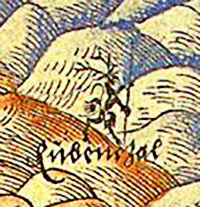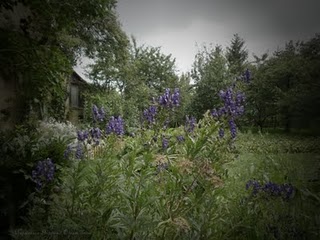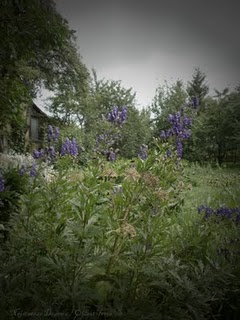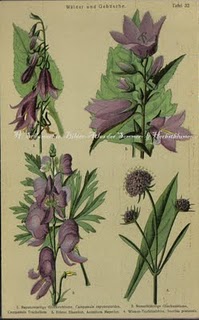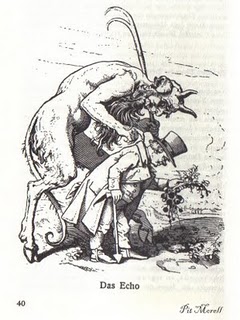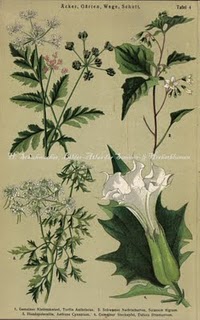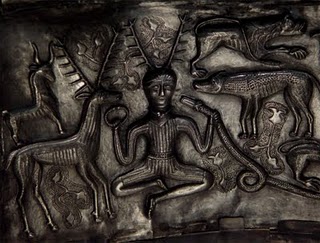Between Isis & Osiris: A Few Notes on the Linguistic Origins of the Names Rübezahl and Karkonosze
The earliest known form of the name „Rübezahl” (Krkonoš, Karkonosz, Rzepiór, Duch Gór, „Liczyrzepa”) is my namesake Martin Helwig’s 1561 RübenƷal in his Landkarte Schlesiens, accompanied by the now-famous image reproduced below.
Najwcześniejsza znana forma imienia „Rübezahl” (Krkonoš, Karkonosz, Rzepiór, Duch Gór, „Liczyrzepa”) to RübenƷal na mapie Śląska autorstwa Marcina Helwiga z roku 1561, zawierającej słynny dzisiaj wizerunek.
Inne wersje pisowni to Rübezal, Rübemzal, Ribezal, Riebenzahl itd.
Dzisiaj powszechnie przyjęta pisownia to Rübezahl.
Znaczenie nazwy „Rübezahl” pozostaje niejasne, ale w w gruncie rzeczy poza oczywistym „Liczyrzepa” – które jest tak głupią nazwą dla demona, że od razu ją odrzucam – pozostałe propozycje oparte są na dwóch zasadniczo przesłankach:
which suggests a Riphean Devil, or Ripheic Demon.
The explanation Rübe = Rabe (raven) seems too far-fetched.
Nie znalazłem dotąd innych przekonywających – a właściwie żadnych – innych teorii na ten temat. Można by wręcz powiedzieć, że panuje w tej kwestii posucha.
Poniżej zaprezentuję dwa alternatywne wyjaśnienia, jedno autorstwa słynnego pisarza, acz sam argument chyba zupełnie szerokiej publiczności nieznany, drugie mojej inwencji.
I would like now to present two other explanations, one by a famous author but (the proposition) seemingly unknown to the general public, the other by myself. On top of that, I will hint at a possible revolutionary – and interconnected with the previous one! – theory on the name Karkonosze – which may possibly reveal who Rübezahl really is.
„W starożytności wykorzystywany był jako zabójcza trucizna, w Europie w okresie renesansu był najczęściej stosowaną trucizną.
W średniowieczu używano go do zatruwania strzał i mieczy.
Ludowa nazwa tojadu nawiązująca do jego trujących właściwości to „mordownik”, zaś Pliniusz Starszy, również nawiązując do jego trujących własności nazywa go „arszenikiem roślinnym”.
(…)
Tojadem otruto podobno Arystotelesa, zaś według Dioskurydesa jad tojadu jest tak silny, że zabija skorpiony.
Według mitologii greckiej tojad powstał ze śliny strażnika Hadesu – psa Cerbera o trzech głowach.”
(It’s occurred to me through this site).
The outstanding Polish geologist Michał Sachanbiński writes very clearly in his 1979 Kamienie szlachetne i ozdobne Śląska [The precious and decorative stones of Silesia] (Chapter 4. Śląskie kamienie szlachetne (jubilerskie): 4.1. Korund i jego barwne odmiany (rubin i szafir): 4.1.1. Korundy w złożach pierwotnych):
Rubin-Erzähler? Weren’t die Walen / Edelsteinsucher / Venetianer/ Walonowie / Walończycy involved precisely in that – counting precious stones? Just as Hermes / Mercury guarded over Greek merchants and tradesmen in the Aegean, so the Rubin Counter made sure the Askiburgic prospectors like (another namesake of mine) Laurentius Angelus or their early researchers like Johannes Prätorius were safe and well…
As we know, Celtic presence is confirmed in the Sudetes as early as in the 4th century BC, and Mount Ślęża is widely believed to have been a major cult centre in the region. Why should we doubt that the Karkonosze played a role in their religious rituals as well? Cernunnos’s Mountains?
This would suggest that Krkonoš is an earlier form than Rübezahl, and that is a proposition I have no problem with: there was certainly greater cultural continuity on the south side of the Sudetes than on the nortth one, which for centuries in the early middle ages remained uninhabited.
So the Czechs got their Krkonoš from their Celtic predecessors’ Cernunnos, while Rübezahl, whole echoing the Celtic god visually, is a later invention, originating either with the Edelsteinsucher / Venetianer / Walen / Walonowie, and derived from „Rubin„, the precious stone, or with the magicians, witches, medicine people, the „Chimici”, and derived from „Rübe„, that is, the poisonous plants used for magic rituals.
Cernunnos being a „horned god” („Cernunnos der Hirschgott”, bóg-jeleń), the theory – suprise, suprise! – connects just nicely with the name Jelenia Góra / Hirschberg, doesn’t it? Cf. here for example: http://www.eichfelder.de/nibelung/parallel/mythen/cernunno.html
Another trope are the Jelenie Skały / Hirschsteine on the north-western slope of the Tłoczyna (Scheibenberg) in the Grzebiet Kamienicki (Kamienica Ridge). Where, of course, the famous and mythical Pagan Chapel (Pogańska Kaplica, Heidnische Kapelle) reportedly used to stand… But this is a subject for a separate study.
Intuicje na temat związku Cernunnosa z Krkonosem / Rübezahlem / Duchem Gór były wyrażane przez różnych autorów, ale w sposób zasadniczo jednak dość luźny i w oparciu wyłącznie o ikonografię (W ogóle wydaje mi się, że lingwistyka jest nieco w odwrocie – poza paroma wyjątkami w rodzaju nieocenionego Moczulskiego („Narodziny Międzymorza”) mało kto robi dzisiaj w słowiectwie / słowiaństwie / słowstwie…):
„Być może bóg Cernunnos pozostaje w jakimś odległym związku z najstarszym wyobrażeniem karkonoskiego Ducha Gór, który dzierży wszak majestatyczny kostur i również nosi nas głowie jelenie rogi”" – pisze Przemysław Wiater w pracy Walonowie u Ducha Gór - zamieszczając dokładnie ten sam wizerunek Cernunnosa, który przecież znam od dawna…
„Pewnych odległych związków z celtyckim czy też późniejszym starogermańskim totemizmem doszukiwać się można w najstarszym przedstawieniu karkonoskiego Ducha Gór z 1561 r., który ukazuje go jako demona składającego się z połączenia elementów zoomorficznych (łeb gryfa z parą jelenich rogów, tylne odnóża kozła”…
„Bardzo interesująca wydaje się być podróż do Indii. W głównym ośrodku starożytnej cywilizacji Mohendżo Daro odnaleziono pieczęć z 2000 roku p.n.e. ukazującą boga z rogami siedzącego na tronie ze skrzyżowanymi nogami. Pasjonująca jest relacja łącząca tę pieczęć z wyobrażeniem celtyckiego boga lasów i zwierząt, Cernunnosa, przedstawionym na kotle z Gundestrup powstałym na terenie dzisiejszej Danii ok. II wieku p.n.e. On również ma na głowie rogi ( choć inne – jelenie), a nogi skrzyżowane ma w bardzo podobnej pozycji. Jego cechy możemy porównać z właściwościami Ducha Gór. Być może w drodze kontaktów ze Wschodem przedstawienie celtyckie mogło być inspirowane indyjskim, bowiem podobieństwo między nimi wygląda na nieprzypadkowe. Stąd płynie dość fantastyczny wniosek, że na wygląd XVI wiecznego rysunku śląskiego wpłynąć mogły o trzy i pół tysiąca lat starsze wizerunki bogów indyjskich” – pisze Berenika Różańska w pracy „Wizerunek Rzepióra i jego związki z innymi przedstawieniami postaci mitologicznych lub legendarnych oraz jego przekształcenia na przestrzeni wieków” (Jelenia Góra, 2006)
Intuicje słuszne, ale brakuje rozstrzygającego argumentu lingwistycznego:
Cer – nun – nos = Kr – k – noš = RübenƷal
Tym bardziej, że nazwa Krkonoš występuje już w roku 1492 (division of the Manor of Štěpanice) – spory kawał czasu wcześniej niż Rübezahl u Helwiga. To znaczy, że – z punktu widzenia faktografii – wszelki wywód powinien się zaczynać od Krkonoša, nie od Rübezahla!
Mamy więc kolejno: kult celtyckiego „boga jelenia” zwanego Cernunnos – nazwę Krkonoš – góry Karkonosze – i leżące u ich stóp miasto Jelenia Góra (‘Deer Mountain’, Hirschberg). Czy naprawdę nie jest tu coś na rzeczy?
In other words: Krkonoš is a linguistic derivative of Cernunnos, while Rübezahl is a visual one.
I jeszcze piękny fragment z „Mitologii Celtów”:
„Tak więc ogier lub klacz, niedźwiedź, dzik i jeleń były totemami u Celtów jeszcze przed wykształceniem się wyżej zorganizowanej religii i pozostały w niej nadal bądź kojarząc się z bóstwami antropomorficznymi [ludziopodobnymi], bądź też schodząc do roli ich atrybutów. Nie tylko jednak zwierzęta pełniły rolę totemów w najdawniejszych wierzeniach celtyckich. Można sądzić z dużą dozą prawdopodobieństwa, iż totemami były niektóre rośliny, szczególnie zaś drzewa. Wiemy, że w praktykach liturgicznych druidów ważne miejsce zajmowały zwłaszcza dąb i cis. Wydaje się zresztą, że dąb należy do tych drzew, które czciły wszystkie ludy indoeuropejskie; święte dęby i dąbrowy przetrwały długo także w obrzędowości ludowej Słowian”… (s. 67)
Well, I’ll leave it at that for today. Have fun thinking this over!
[Written to the sound of Wiseman by Desmond Dekker, 1967: "A wise man keepeth his life And the life of his wives and kin A wise man keepeth his life And the life of his wives and kin"...]
And hey, don’t Isis, Osiris and Horus have something to do with horns/antlers?
Dzięki uprzejmości Leszka Różańskiego prezentuję poniższą wspaniałą robotę: tablicę Bogowie, stwory mityczne, demony i diabły: protoplaści wizerunku Ducha Gór (dodatek autorstwa Stanisława Firszta do jego własnego artykuł pt. Kim jest Duch Gór?, „Skarbiec Ducha Gór”, nr 4 (24). 2002):
A oto sam artykuł, w którym na końcu objaśnienia do tablicy:
Jednak tak jak i inni, choć Firszt dopuszcza jako jeden z wielu możliwych związek Ducha Gór / Rübezahla z Cernunnosem, to nie zauważa uderzającego podobieństwa Krkonoš = Cernunnos.
[Askiburgion, Berenika Różańska, Duch gór, Eisenhut, Hexen, Karkonosz, korund. Rubinzahl, Krakonoš, Krkonoš, Liczyrzepa, Riefenzabel, Riphaei Montes, rubin, Rübezahl, Sergius Golowin, Stanisław Firszt, Skarbiec Ducha Gór]
Źródło: Between Isis & Osiris: A Few Notes on the Linguistic Origins of the Names Rübezahl and Karkonosze

